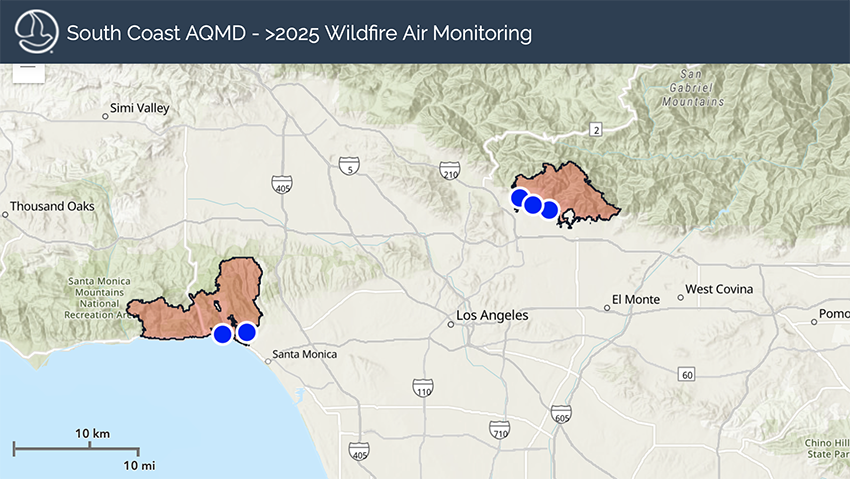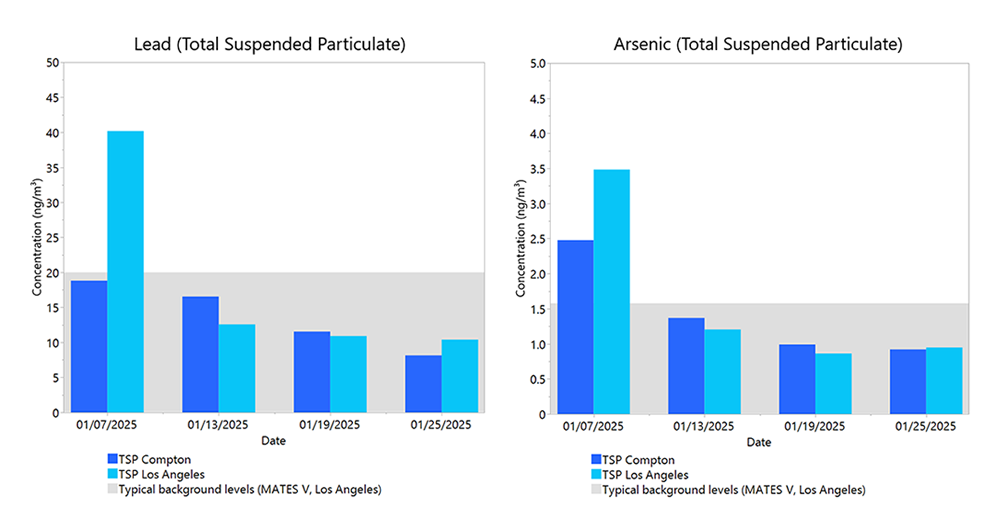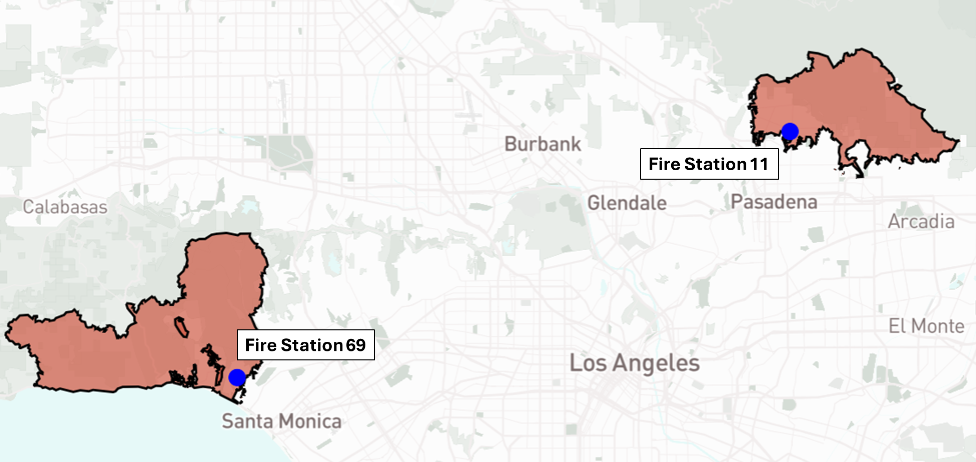Eaton & Palisades Air Monitoring
Update: To date, monitoring results have not shown any levels of concern, even during peak debris removal activities. The U.S. Army Corps of Engineers has substantially completed debris removal efforts and South Coast AQMD has concluded its expanded monitoring on July 8th, 2025.
Air monitoring sites were chosen based on first survey results, cleanup activity, proximity to sensitive receptors (such as residents and schools), meteorological conditions, and access to power and security for the monitoring equipment. Data from these sites helped evaluate potential health impacts to communities close to cleanup activities and provide information on air quality conditions in the vicinity of staging areas and truck routes.
Stationary air monitoring data was used to evaluate community exposure and may be used to determine public health impacts.
The sites monitored particulate matter (PM2.5 and PM10), air toxic metals and asbestos.
Site Locations
Air Sampling and Data Reporting
- Continuous Monitoring: The site measured PM2.5 and PM10 hourly. Results were available daily.
- Scheduled Sampling: Air toxic metals and asbestos were sampled every three days. The monitors collected an air sample continuously over a 24-hour period. The samples were then collected and delivered for expedited laboratory analysis. Data was available approximately one week after collection.
Click on the map below to be transferred to the data dashboard

Mobile Air Monitoring
Efforts
Mobile surveys measure for air toxic metals and volatile organic compounds (VOCs). The full list of pollutants measured can be found here. Please note, these surveys capture a snapshot (less than 5 min).
Mobile surveys do not sample long enough at a location to establish risks to human health. They are used to identify potential hot spots and help guide where stationary monitoring sites may be needed.
Eaton Fire Area
Mobile Survey #1: Results from the January 31, 2025 mobile survey show no elevated levels of:
- Air toxic metals including lead and arsenic (Figures 1 and 2)
- VOCs including benzene (Figure 3)
Overall, the results were within background levels (air quality on a typical day). Some elevated levels of methane, possibly from gas leaks (Figure 4), were detected. These results were reported to utilities and public health agencies for further investigation
1/31/2025 (Click map below to enlarge)
Mobile Survey #2: Results from the February 19, 2025 mobile survey show:
- Overall, the majority of results were within background levels.
- Some elevated levels of Lead, Arsenic, Chromium and Nickel (Figures 5, 6, 7, and 8).
- No elevated levels of VOCs including benzene (Figure 10).
In some locations, lead, arsenic, total chromium and nickel were above background levels. One, very brief elevated measurement of benzene was seen, but it was likely due to ongoing work on public sewer lines. Repeated measurements at the same location showed benzene back within typical levels when the work was completed. No elevated levels of methane were seen (Figure 9).
Again, most brief mobile monitoring results were within background levels. For those in burned areas concerned about ash and fire debris, the Los Angeles County Department of Public Health recommends avoiding outdoor areas with significant fire debris during cleanup. If you must be outside, monitor wind direction, air quality, and visible particles, and take precautions like limiting outdoor activities, keeping windows closed, and wearing masks or respirators. For more details, visit the Public Health wildfire webpage.
2/19/2025 (Click map below to enlarge)
Palisades Fire Area
Mobile Survey #1: Results from the February 10, 2025 mobile survey show no elevated levels of:
- Air toxic metals including lead and arsenic (Figures 11 and 12)
- VOCs including benzene (Figure 13)
Overall, the results were within background levels (air quality on a typical day). One elevated level of methane, possibly from a gas leak (Figure 14), was detected and reported to utilities and public health agencies for further investigation.
2/10/2025 (Click map below to enlarge)
Mobile Survey #2: Results from the February 21, 2025 mobile survey show:
- Overall, the majority of results were within background levels.
- Some elevated levels of Lead, Arsenic, Chromium and Nickel (Figures 15, 16, 17,18)
- No elevated levels of VOCs including benzene (Figure 19)
In some locations, lead, arsenic, total chromium and nickel were above background levels. Some elevated levels of methane were detected. Our investigation into potential sources is ongoing. (Figure 20 ).
Again, most brief mobile monitoring results were within background levels. For those in burned areas concerned about ash and fire debris, the Los Angeles County Department of Public Health recommends avoiding outdoor areas with significant fire debris during cleanup. If you must be outside, monitor wind direction, air quality, and visible particles, and take precautions like limiting outdoor activities, keeping windows closed, and wearing masks or respirators. For more details, visit the Public Health wildfire webpage.
2/21/2025 (Click map below to enlarge)
Air Monitoring Network
South Coast AQMD provides information about regional air quality through an existing air monitoring network that includes regulatory monitors, portable instruments and private sensors. This includes regional pollutants such as ozone, particulates (found in wildfire smoke and dust), sulfur dioxide, carbon monoxide and nitrogen dioxide.
Regional Air Toxic Metals
- South Coast AQMD conducts lead measurements at seven locations throughout the Basin, as part of its overall, ongoing air monitoring program.
- Lead, arsenic, and other air toxic metals are also measured at several sites in Los Angeles County.
- These sites are part of South Coast AQMD’s routine air monitoring network and are not specific to the wildfire response.
- Data from these sites should not be used to draw conclusions on levels of air toxics within the burn areas.
- The Palisades and Eaton fires both began on January 7, 2025. Data analyzed between January 7 and January 11 from air monitors impacted by the smoke plume show that air toxic metals (e.g., arsenic and lead) were highly elevated, even compared to other fires in our region that occurred in non-urban areas (i.e., Bridge and Rabbit fires).
- After January 12, air toxic metals have decreased significantly and are now generally similar to pre-fire levels.

- Additional analysis was conducted to compare measured regional air toxic levels and reported AQI values.
- In areas downwind of the fires, preliminary analysis shows that when levels of air toxic metals increased, AQI also increased. At the Huntington Park monitor, when levels of air toxic metals were above typical levels, the AQI was “Unhealthy for Sensitive Groups” or worse 98% of the time.
Real time air quality information can be found on South Coast AQMD’s AQI Map at: https://www.aqmd.gov/aqimap
Sign up for air quality advisories at: https://www.airalerts.org
Download our free mobile app (available in English and Spanish) at: https://www.aqmd.gov/mobileapp
Precautions for
Local Residents
Exposure to smoke and ash from the wildfires remains a potential health concern. Ash is typically visible to the naked eye either in the air or on outdoor surfaces.
The public should take precautions when any one of the following occurs:
Precautions include:
- Limiting your exposure by remaining indoors with windows and doors closed or seeking alternate shelter.
- If you have to be outside, wearing an N-95 mask can provide some protection.
- Avoiding vigorous physical activity.
- Running your HVAC system and/or an air purifier.
- If possible, do not use swamp coolers or whole house fans that bring in outside air.
Asbestos:
- Asbestos is a dangerous carcinogen that is known to be present in walls, roofing, insulation, and other parts of houses and other structures (regardless of the age of a building).
- Consequently, there is a high likelihood that asbestos will be found in debris from structures burned by the wildfires.
- Asbestos fibers can become airborne if disturbed and create a health hazard when inhaled, so any structures or items burned by the wildfires should therefore be avoided (see Precautions for Local Residents above).
- For more information, please visit South Coast AQMD’s dedicated page for Asbestos Demolition & Removal.
Avoid attempting to clean up fire debris – i.e., damaged structures, furniture, personal belongings, vehicles, vegetation, or other items that have been burned by the wildfires. The Los Angeles County Department of Public Health (LADPH) and the Pasadena Public Health Department, issued orders prohibiting the unsafe removal, transport, and disposal of fire debris.
If it is necessary for you to clean up ash that is impacting living or work spaces in areas not damaged by fire, please use the following general precautions:
- Always put on personal protective wear (e.g., long sleeve shirts, pants, gloves and safety glasses) when you must be around ash for an extended period of time
- A well-fitting respirator, such as an N-95 mask, may provide some protection
- If you do get ash on your skin, wash it off as soon as possible
- All clothing, shoes and other protective wear should be removed, wiped or cleaned as appropriate before entering your residence
- Do not use leaf blowers or take other actions (e.g., dry sweeping) that will put ash into the air
- To clean up ash, use vacuums equipped with High Efficiency Particulate Air (HEPA) filters or mist lightly with water before gently sweeping
For More Wildfire Smoke, Ash and Safety Tips, visit: https://www.aqmd.gov/wildfiretips
Hexavalent Chromium Air Monitoring
South Coast AQMD initially concluded its air monitoring efforts in July 2025. In August 2025, we became aware of a draft report released by LA HEALTH Study Fire researchers at UC Davis and UCLA. The study was limited in scope (a total of four hex chrome samples) and used novel methods outside of regulatory methodologies but raised important questions.
South Coast AQMD launched a one-month monitoring evaluation to further assess levels of hexavalent chromium and 33 other air toxic metals including lead and arsenic in these impacted areas. Regulatory-grade monitors were used to collect samples once every three days from September 10 to October 7, 2025.
South Coast AQMD continues to engage with the researchers to strengthen the information available to evaluate hexavalent chromium in the communities during the measurement periods.
Air Monitoring Data, Report, and Assessment
Monitoring results during the one-month air monitoring evaluation did not show any levels of concern. Concentrations of hexavalent chromium and other toxic metals (including lead and arsenic) remained within regional background levels for all samples.
Typical background levels are established based on the Multiple Air Toxics Exposure Study (MATES V), which sets a baseline for air toxics across the South Coast Air Basin. The results indicate that air quality in the impacted zones has largely returned to pre-wildfire conditions.
All monitoring results are available through the interactive data plot below, where users can explore the measurements by pollutant or download the data directly.
Monitoring will continue until mid-October 2025, with results posted as they become available.
Air Monitoring Locations
Eaton Burn Area: Fire Station 11
Pacific Palisades Burn Area: Fire Station 69

The United States Environmental Protection Agency’s (U.S. EPA) 2025 Southern California Wildfire Response webpage
Los Angeles County’s LA County Recovers includes various online resources, such as interactive maps for each fire, Frequently Asked Questions, and links to community assistance programs. Los Angeles County Department of Public Heath LADPH has also created online resources
Eaton and Palisades Air Monitoring Update - July 11, 2025
Eaton and Palisades Air Monitoring Update - July 3, 2025
Eaton and Palisades Air Monitoring Update - June 26, 2025
Eaton and Palisades Air Monitoring Update - June 20, 2025
Eaton and Palisades Air Monitoring Update - June 13, 2025
Eaton and Palisades Air Monitoring Update - June 5, 2025
Eaton and Palisades Air Monitoring Update - May 30, 2025
Eaton and Palisades Air Monitoring Update - May 23, 2025
Eaton and Palisades Air Monitoring Update - May 16, 2025
Eaton and Palisades Air Monitoring Update - May 9, 2025
Eaton and Palisades Air Monitoring Update - May 2, 2025
Eaton and Palisades Air Monitoring Update - April 25, 2025
Eaton and Palisades Air Monitoring Update - April 18, 2025
Eaton and Palisades Air Monitoring Update - April 11, 2025
Eaton and Palisades Air Monitoring Update - April 4, 2025
Eaton and Palisades Air Monitoring Update - March 28, 2025
Eaton and Palisades Air Monitoring Update - March 21, 2025
Eaton and Palisades Air Monitoring Update - March 14, 2025
Eaton and Palisades Air Monitoring Update - March 6, 2025
Eaton and Palisades Air Monitoring Update - March 1, 2025
South Coast AQMD Launches Dashboard for Air Monitoring Data - February 22, 2025
New Air Monitoring Sites Deployed for Eaton and Palisades Fires - February 20, 2025
South Coast AQMD Expands Air Quality Monitoring for Eaton and Palisades Fires - January 31, 2025
South Coast AQMD Reminds Residents to Take Precautions to Avoid Exposure to Wildfire Ash - January 15, 2025
South Coast AQMD Advises Residents to take Precautions as Ash Remains a Concern due to Wildfires - January 14 2025